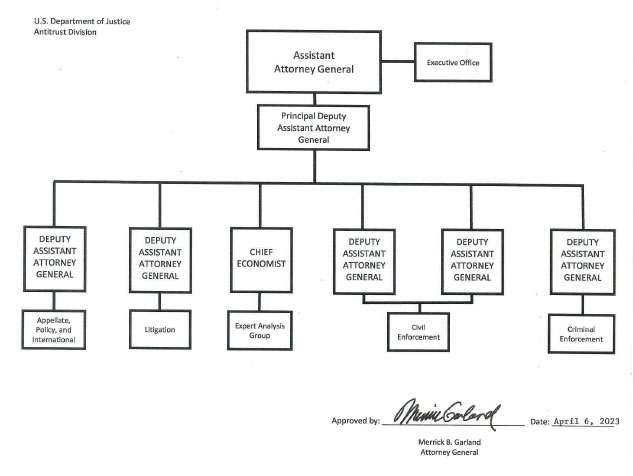Antitrust Division
Antitrust Division Organizational Chart
Antitrust Division Organizational Chart Description
The Assistant Attorney General (AAG) for Antitrust manages the entire Division.
- The Executive Office reports directly to the AAG.
- One Principal Deputy Assistant Attorney General (PDAAG) reports directly to the AAG.
- The following five Deputy Assistant Attorneys General (DAAG) and the Chief Economist report directly to the PDAAG:
- One DAAG who manages the Appellate, Policy and International Section.
- One DAAG who manages the Litigation
- Chief Economist manages the EAG Group: Economic Litigation Section, Economic Policy Section, Economic Regulation Section
- Two DAAGS who manage the following civil program offices: Healthcare and Consumer Products Section; Defense, Industrials, and Aerospace Section; Media, Entertainment, and Communications Section, Technology and Digital Platforms Section; Financial Services, Fintech, and Banking Section; and Transportation, Energy, and Agriculture Section.
- One DAAG who manages the criminal program offices: Chicago, New York, San Francisco, Washington Crim. I and Washington Crim. II
The organizational chart is approved (and signed) by: Merrick B. Garland, Attorney General and dated April 6, 2023.
History
The Division’s organizational roots can be traced to the creation of the role of an Assistant to the Attorney General in March 1903 to take charge of all suits under the antitrust and interstate commerce laws and to assist the Attorney General and the Solicitor General in the conduct of the general executive work of the Department. The post was created under President Theodore Roosevelt and Attorney General Philander Knox. With the growth of the economy and of corporate enterprise, it became evident that the Department of Justice must have its own corps of specialists in antitrust law to cope with an increasingly complex enforcement situation. Consequently, in 1933 under the administration of President Franklin D. Roosevelt and Attorney General Homer S. Cummings, the Antitrust Division was established.
The three key federal statutes in Antitrust Law are Sherman Act Section 1, Sherman Act Section 2, and the Clayton Act.
Mission
The mission of the Antitrust Division is to promote competition in the U.S. economy through enforcement of, improvements to, and education about antitrust laws and principles.
Competition in a free market benefits American consumers, workers, and taxpayers: it provides consumers with lower prices, better quality, greater choice, and innovation; it provides workers with job opportunities, higher wages, better benefits, and other terms of employment; and it ensures that taxpayer dollars are well spent on goods and services for the public’s benefit rather than lost to collusion. Competition provides businesses the opportunity to compete on price, quality, innovation, and wages, in an open market and on a level playing field, unhampered by anticompetitive restraints. Federal antitrust laws apply to virtually all industries, including technology and healthcare, and to every aspect of business, including manufacturing, transportation, distribution, labor, and marketing. They prohibit a variety of practices that restrain trade, such as price-fixing conspiracies, corporate mergers whose effect may be to substantially lessen the competitive vigor of particular markets, interlocking directorates which create a risk of collusion, and predatory acts designed to achieve or maintain monopoly power.
Major Functions
The major functions of the Antitrust Division are to:
- Seek to prevent or terminate private anti-competitive conduct that is subject to criminal and civil action under the Sherman and Clayton Acts and related statutes that prohibit conspiracies in restraint of trade, monopolization, and anti-competitive mergers.
- Review proposed mergers and acquisitions to assess their competitive effect and challenge those that threaten to harm competition.
- Investigate and prosecute violations of criminal law that affect the integrity of the investigatory process, and enforce various criminal statutes related to Sherman Act violations.
- Investigate possible violations of the federal antitrust laws, conduct grand jury proceedings, issue and enforce civil investigative demands, and handle all litigation that arises out of these criminal and civil investigations.
- Develop and present legislative proposals of the Department relating to the antitrust laws and competition generally and respond to requests for advice and comments on such matters from Congress and from other agencies.
- Through participation in the executive branch, regulatory, and legislative processes, seek to ensure that government action is pro-competitive or not unnecessarily anti- competitive.
- Assemble information and prepare reports required or requested by the Congress or the Attorney General as to the effect upon the maintenance and preservation of competition under the free enterprise system of various federal laws or programs.
- Advise the President and the departments and agencies of the executive branch on the competitive implications of governmental action.
Antitrust Division Field Offices

States with field offices: CA IL NY
States with no field offices: AK AZ AR AL CO CT DE FL GA HI IA ID IN KS KY LA MA MD ME MI MN MO MS MT NC ND NE NH NJ NM NV OH OK OR PA RI SC SD TN TX UT VA VT WA WI WV WY
Note - ATR Division has 3 field offices as of May 2024. For additional information on field operations, see its website.
Click on map for larger version


